Bolsover Castle: From Fortress to Fantasy
by Elaine Walker
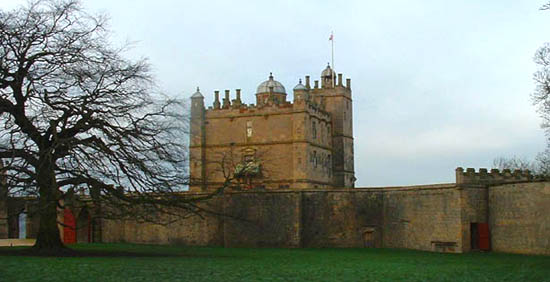
Bolsover Castle appears as a surprise from whichever way you approach. Coming off the M1 motorway at junctions 29 or 30, you drive through reminders of Derbyshire's industrial heritage to find a castle from a fairytale looking down at you from its high vantage point. If you approach through Bolsover town itself, on the A632 from Chesterfield, the castle appears as you round a corner, the backdrop to a row of modern houses. While it may echo the honey-coloured limestone of the surrounding area, its towers and turrets make it seem from another time and place, scarcely associated with its location.
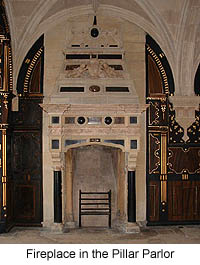 This is in some ways true. Bolsover Castle, pronounced locally as 'Bozer', was in its glory days the fantasy creation of William Cavendish, Earl, Marquis and later first Duke of Newcastle, whose main residence was the nearby Welbeck Abbey. The two houses were distinguished by practicality and beauty and one guest in 1668 wrote that William had 'Welbecke for use and Bolser for sighte'. The beauty of Bolsover made this the place he chose to entertain his guests, a pleasure palace where the finer points of art and culture could be enjoyed by the nobility of the 17th century. William was a man famed for his elaborate self-presentation and loyalty to the crown, which came together in theatrical entertainments for the king and queen, one written especially for their visit to Bolsover. A love of the arts and desire for a high place at court meant that William was frequently troubled for cash, but this never stopped him in his pursuit of beauty and position. Bolsover Castle is a nutshell version of the pleasures of one man's life, and a day spent within its walls offers not only the enjoyment of a lovely building, but also an insight into a fascinating man. This is in some ways true. Bolsover Castle, pronounced locally as 'Bozer', was in its glory days the fantasy creation of William Cavendish, Earl, Marquis and later first Duke of Newcastle, whose main residence was the nearby Welbeck Abbey. The two houses were distinguished by practicality and beauty and one guest in 1668 wrote that William had 'Welbecke for use and Bolser for sighte'. The beauty of Bolsover made this the place he chose to entertain his guests, a pleasure palace where the finer points of art and culture could be enjoyed by the nobility of the 17th century. William was a man famed for his elaborate self-presentation and loyalty to the crown, which came together in theatrical entertainments for the king and queen, one written especially for their visit to Bolsover. A love of the arts and desire for a high place at court meant that William was frequently troubled for cash, but this never stopped him in his pursuit of beauty and position. Bolsover Castle is a nutshell version of the pleasures of one man's life, and a day spent within its walls offers not only the enjoyment of a lovely building, but also an insight into a fascinating man.
The castle began life in the 12th century as a fortification belonging to the Perevel family, most likely similar in design to their nearby castle at Castleton, the ruins of which may be still be seen. Bolsover changed hands a number of times until its materials were stripped and sold during the 14th century. It remained in a sorry state until it became a favourite project of Sir Charles Cavendish in 1608, and later his son William. Following his father's example, through his youth and maturity William devoted himself to developing this most beloved of his residences and it is his mark that is largely stamped on the castle you can see today.
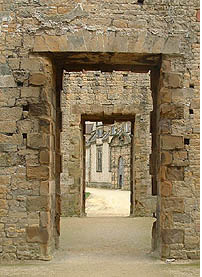 The practicalities of your visit are easily dealt with. There is a choice of parking close to the castle and toilets are available before you enter the Visitor Centre, a well designed and comfortable building offering souvenirs, information and refreshments. Bolsover Castle belongs to English Heritage, so members gain free admission, while an adult ticket for nonmembers is £6.50 with concessions from £4.90 down to £3.30 for children. The price includes a comprehensive audio tour, which provides interesting historical and architectural information, while activity sheets are available for younger visitors. The castle is also available for civil weddings, corporate hospitality and educational visits. It is a site that is under constant improvement and development and is very visitor friendly, although disabled accessed is limited in parts by the 17th century design. The practicalities of your visit are easily dealt with. There is a choice of parking close to the castle and toilets are available before you enter the Visitor Centre, a well designed and comfortable building offering souvenirs, information and refreshments. Bolsover Castle belongs to English Heritage, so members gain free admission, while an adult ticket for nonmembers is £6.50 with concessions from £4.90 down to £3.30 for children. The price includes a comprehensive audio tour, which provides interesting historical and architectural information, while activity sheets are available for younger visitors. The castle is also available for civil weddings, corporate hospitality and educational visits. It is a site that is under constant improvement and development and is very visitor friendly, although disabled accessed is limited in parts by the 17th century design.
A visit to the castle begins with entry through the imposing gateway, which leads to a fine view of the Great Court, with the main house, the Little Castle, appearing over the outer wall of the garden. Nearby, a detailed model of the site as it was in the 1660s shows that the gate you have passed through was once the rear entrance, with the formal approach being along the South Drive. A gate in the walled garden leads up a wide drive in a direct line to the door of the Riding House. This use of aligned doorways is a feature of the site that illustrates a fashion of the 17th century. Being able to see through a doorway to another and yet another beyond showed that the owner could afford an extensive range of rooms and buildings.
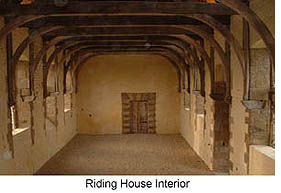 The Riding House itself (shown below) was evidence of status and a cultured taste during a time when the passion for horsemanship as an art was flourishing. William's Riding House, one of the earliest to be built in England, was a state-of-the-art design and was said to be 'more extraordinarie, than are to bee seene in Europe' by his contemporaries. Still used on occasions for demonstrations of 17th century horsemanship, filming and Riding for the Disabled, the Riding House is a jewel of its kind, and the finest surviving example in this country. The Riding House itself (shown below) was evidence of status and a cultured taste during a time when the passion for horsemanship as an art was flourishing. William's Riding House, one of the earliest to be built in England, was a state-of-the-art design and was said to be 'more extraordinarie, than are to bee seene in Europe' by his contemporaries. Still used on occasions for demonstrations of 17th century horsemanship, filming and Riding for the Disabled, the Riding House is a jewel of its kind, and the finest surviving example in this country.
The building recalls a part of the equine history that may be traced through to today's dressage. William wrote two books on horsemanship, the first and only significant British contributions to the development of the art. His Riding House at Bolsover underwent detailed restoration in 1999/2000 and there is still some debate over its actual date of construction. Building was likely to have begun in the 1630s but there was a complete renovation in the 1660s, after the deprivations of the Civil War.
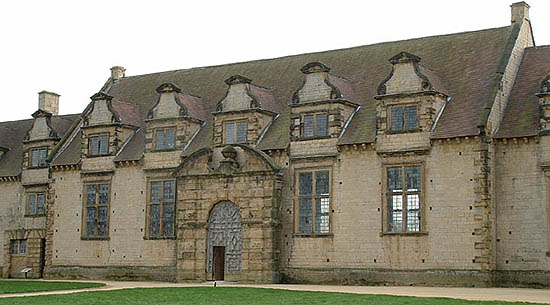
From the Riding House, visit the interpretative centre in the old stables, where there is a charming model of the little castle for children to play in and some interesting features and information on the building. Sadly, the information on horsemanship is not very accurate, but overall, it is nevertheless very attractive and imaginative. Beyond the Riding House Range, the shell of the Terrace Range looks out over wonderful views of the surrounding countryside.
The Terrace Range was built in the 1630s and represents one of William Cavendish's many financial risks in his quest for court position. It was designed and built with a view to entertaining King Charles I and Queen Henrietta Maria, a plan which was fulfilled in 1634. Poet and playwright Ben Jonson was commissioned to write an entertainment for the royal couple, called Love's Welcome. The whole event, though greatly enjoyed by the King, left William deeply in debt.
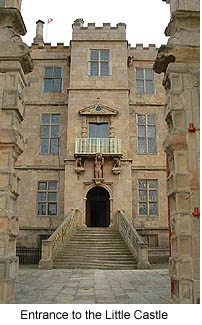 Long derelict, the Terrace Range offers an insight into the construction of such a building, as you can look down through the missing floors to see the layout and design. You will also see more of the aligned doorways and enjoy some wonderfully quirky views of doorways framed within doorways, with the Little Castle or the Riding House glimpsed as the distant focal point. The ingenuity of design, by the famous Smithson family of architects, makes the whole site a real pleasure, as there is both style and wit in its composition. Long derelict, the Terrace Range offers an insight into the construction of such a building, as you can look down through the missing floors to see the layout and design. You will also see more of the aligned doorways and enjoy some wonderfully quirky views of doorways framed within doorways, with the Little Castle or the Riding House glimpsed as the distant focal point. The ingenuity of design, by the famous Smithson family of architects, makes the whole site a real pleasure, as there is both style and wit in its composition.
From the Terrace Range, visit the Little Castle. Like the Riding House, the Little Castle has undergone considerable restoration in recent years. The attention to detail extends to the mixing of paint from authentic materials of the 17th century. The colours were chosen from analysis of the scrapings from the layers of many years so that the colours you see today are those William himself would have chosen and approved. Although William's love of Bolsover Castle led to constant development and change throughout his lifetime, it was almost destroyed during the Civil War and only the swift intervention of his devoted brother prevented compete demolition. William spent 16 years in exile on the Continent as one of the most hated enemies of the Parliamentarians, but on his return after the restoration of Charles II, he applied himself diligently to its renovation.
As you move through the Little Castle, you travel from earthly to heavenly concerns, as each room is decorated with a specific focus in mind. The labours of Hercules are introduced with his statue over the main entrance, and go on to form the decoration of the Hall. A philosophical concern of the 17th century was the reconciling of pleasure to virtue and the decoration of the Little Castle may be seen as an allegory illustrating this dilemma.
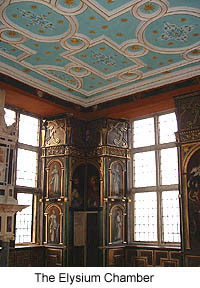 William's earthly pleasures -- the love of horses, music and art -- may be seen in both the main decoration and also in details such as the leaping horses that decorate the pillars in the Pillar Parlour. The romping female nudes in the Marble Closet recall another of his interests, while the music held by the cherubs in the Heaven Room comes from a song about Robin Hood. As William was responsible for the overseeing of Sherwood Forest on behalf of the King, and Welbeck Abbey was located in the forest, this becomes yet another reference to him. William's earthly pleasures -- the love of horses, music and art -- may be seen in both the main decoration and also in details such as the leaping horses that decorate the pillars in the Pillar Parlour. The romping female nudes in the Marble Closet recall another of his interests, while the music held by the cherubs in the Heaven Room comes from a song about Robin Hood. As William was responsible for the overseeing of Sherwood Forest on behalf of the King, and Welbeck Abbey was located in the forest, this becomes yet another reference to him.
The Heaven room is one of two closets that lead off William's own bedroom, and illustrates spiritual concerns with scenes from the life of Christ. The other closet is the Elysium room, decorated with Classical scenes of the pagan heaven of gods and goddesses. The two closets seem to offer the ultimate choice of virtue or pleasure while a banner in the Elysium room offers the cautious reminder that 'All is But vanitie.'
While the upper rooms and kitchens below ground level are not decorated, their emptiness draws attention to the beautiful design features such as the octagonal lantern that lights the top storey of the house and the functional channels for water in the beer cellar and the sculleries. A video in the beer cellar adds to the information of the audio tour and is enjoyable for children as well as adults. Before leaving the kitchens, you might like to spare a sympathetic thought for the staff that had to prepare the meals and then carry them up the three staircases to the rooms above!
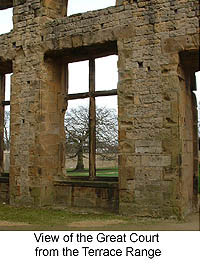 The walled gardens are neat and attractive, with small fireplaces arranged in the perimeter wall to provide heat for the growing of tender fruits and vines. In the centre, a decorous nude stands on her fountain, surrounded by satyrs and lustful mythical beasts and overlooked from the balcony of the Elysium room. While the bathing lady is generally considered to be Venus, goddess of love, another possible interpretation is that she is Bathsheba. Any gentleman who should spy on her from the balcony above plays the part of King David, for whom the dilemma between pleasure and virtue had significant results. The fountain has undergone considerable restoration and some of the statues, like Hercules, have been reconstructed from fragments. The walled gardens are neat and attractive, with small fireplaces arranged in the perimeter wall to provide heat for the growing of tender fruits and vines. In the centre, a decorous nude stands on her fountain, surrounded by satyrs and lustful mythical beasts and overlooked from the balcony of the Elysium room. While the bathing lady is generally considered to be Venus, goddess of love, another possible interpretation is that she is Bathsheba. Any gentleman who should spy on her from the balcony above plays the part of King David, for whom the dilemma between pleasure and virtue had significant results. The fountain has undergone considerable restoration and some of the statues, like Hercules, have been reconstructed from fragments.
A ramble around the courtyard leads at last back to the visitor centre, where the cafe is open from April to October, with a drinks machine available out of season. Bolsover is unusual in the Derbyshire properties in that it is open all the year round, although it is closed on Tuesday and Wednesday between the end of August and the beginning of May and has shorter opening hours in the darker months. It is a site that can be enjoyed in just a few hours, or provide a day's outing if taken at a more leisurely pace. It may be combined perhaps with a visit to nearby Hardwick Hall, the ambitious creation of William's grandmother, the oft-married Bess of Hardwick, from whom he seems to have inherited his love of architecture. Further afield, the castle at Nottingham was William's last great building project. Unfortunately, he did not survive to see it completed, although he did live into his 80s, a significant age for a man in the 17th century. He was buried in Westminster Abbey, alongside his second wife, Margaret, where he is immortalised as 'the Loyall Duke'.
More Information:
We regret that we no longer have the resources to maintain up-to-date links and/or hours and pricing details for the various sites and attractions listed on this website. For more information about the location(s) listed above, please use your favorite search engine or visit Wikipedia.
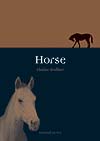 |
Dr. Elaine Walker is a freelance writer based in North Wales. She writes fiction, poetry and nonfiction and lectures in Creative Writing and English for the University of Wales. Her first full-length book, Horse, is forthcoming from Reaktion Books in Autumn 2008.
|
Article and photos © 2005 Elaine Walker
|
